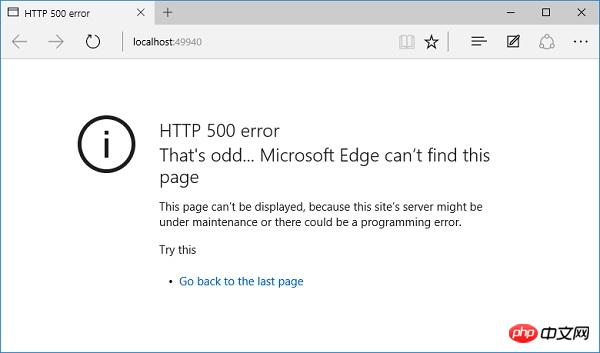
이 글에서는 ASP.NET 핵심 예외 및 오류 처리 관련 정보를 주로 소개합니다. 관심 있는 친구가 참고할 수 있습니다.
이 장에서는 예외 및 오류 처리에 대해 설명합니다. ASP.NET Core 애플리케이션에서 오류가 발생하면 다양한 방법으로 오류를 처리할 수 있습니다. 미들웨어를 추가하여 예외 처리를 살펴보겠습니다. 이 미들웨어는 오류를 처리하는 데 도움이 됩니다.
오류를 시뮬레이션하려면 애플리케이션으로 이동하여 실행하고 예외를 발생시키면 프로그램이 어떻게 작동하는지 살펴보겠습니다.
using Microsoft.AspNet.Builder;
using Microsoft.AspNet.Hosting;
using Microsoft.AspNet.Http;
using Microsoft.Extensions.DependencyInjection;
using Microsoft.Extensions.Configuration;
namespace FirstAppDemo {
public class Startup {
public Startup() {
var builder = new ConfigurationBuilder()
.AddJsonFile("AppSettings.json");
Configuration = builder.Build();
}
public IConfiguration Configuration { get; set; }
// This method gets called by the runtime.
// Use this method to add services to the container.
// For more information on how to configure your application,
// visit http://go.microsoft.com/fwlink/?LinkID=398940
public void ConfigureServices(IServiceCollection services) {
}
// This method gets called by the runtime.
// Use this method to configure the HTTP request pipeline.
public void Configure(IApplicationBuilder app) {
app.UseIISPlatformHandler();
app.UseRuntimeInfoPage();
app.Run(async (context) => {
throw new System.Exception("Throw Exception");
var msg = Configuration["message"];
await context.Response.WriteAsync(msg);
});
}
// Entry point for the application.
public static void Main(string[] args) => WebApplication.Run<Startup>(args);
}
}
// This method gets called by the runtime.
// Use this method to configure the HTTP request pipeline.
public void Configure(IApplicationBuilder app) {
app.UseIISPlatformHandler();
app.UseDeveloperExceptionPage();
app.UseRuntimeInfoPage();
app.Run(async (context) => {
throw new System.Exception("Throw Exception");
var msg = Configuration["message"];
await context.Response.WriteAsync(msg);
});
}
위 내용은 ASP.NET Core 예외 및 오류 처리(8)_실용 팁의 상세 내용입니다. 자세한 내용은 PHP 중국어 웹사이트의 기타 관련 기사를 참조하세요!